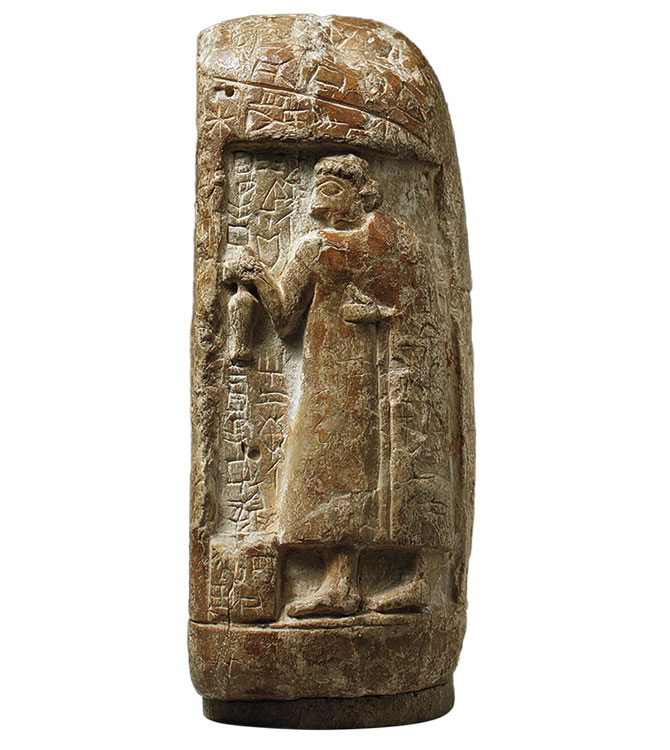This stele, bearing the earliest known signature of an artist, records one of the first transactions involving land, livestock, and houses. The two principal figures—Ushumgal, a priest of the god Shara, and his daughter Shara-igizi-Abzu—face one another on two sides. They are identified by inscriptions carved on their bodies. Shara-igizi-Abzu, who holds a vessel in her right hand, is shown taller than her father. Behind her appears a smaller female figure, and behind Ushumgal are three male figures in two registers, all of whom may have witnessed the transaction that takes place in front of a monumental building. Shara-igizi-Abzu’s prominent appearance suggests that the stele documents Ushumgal’s donation of an estate on her behalf.
Stele of Shara-igizi-Abzu
Mesopotamia, Sumerian, possibly Umma (modern Tell Jokha)
Early Dynastic I–II period, ca. 2900–2600 BC
Cuneiform inscription identifying Shara-igizi-Abzu; her father, Ushumgal; and four other represented figures, including: IGI.RU?.NUN, daughter of Mesi; Ag, chief of the assembly; Nanna, the foreman of the assembly; X.KU.EN, chief herald; Enhegal, the maker of the stele
Gypsum alabaster
The Metropolitan Museum of Art, New York, Funds From Various Donors, 1958; 58.29
Sidney Babcock: Enhegal, the maker of the stele, Gypsum alabaster; The Metropolitan Museum of Art, New York, Funds from various donors, 1958; 58.29
When we think of famous artists from antiquity, ancient Greek names such as Praxiteles or Phidias often come to mind. In fact, the earliest known artist who signed his art was the maker of this very stele, Enhegal. When he finished carving this work, he added his signature in cuneiform and immortalized his name.
What Enhegal carved was a visual record of a financial transaction. He placed each of the principal figures on two main sides and identified them through inscriptions: One of them is Shara-igizi-Abzu, the other is her father Ushumgal. They were most likely from the Sumerian city of Umma, where Ushumgal worked as a priest. Here, signifying her prominent position, Shara-igizi-Abzu is depicted taller than her father. The rest of the inscription suggests that she was the recipient of an estate donated by Ushumgal. The smaller figures depicted on the other faces of the stele are witnessing this transaction.
Now, look at the building before Ushumgal. In the middle of the wall, you will see a little notch. This is for a peg inserted into a building to proclaim this transaction. We have seen one of such pegs in another artwork on view here, namely in the hands of the male figure before KA-GÍR-gal.


